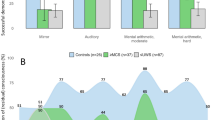Abstract
This study investigated the correlation of caloric- and vestibular-evoked myogenic potential (VEMP) results with topographical lesions of lateral medullary infarction. Five patients with lateral medullary infarction were enrolled in this study. Each patient underwent a battery of tests, including audiometry, caloric test, VEMP test, and magnetic resonance imaging (MRI) study. Gaze nystagmus was observed in four patients (80%), while abnormal pursuit, saccade, and optokinetic nystagmus tests were noted in all patients (100%). MRI demonstrated infarction at the ponto-medullary junction in one patient and upper medulla in one patient. Both patients revealed caloric areflexia and normal VEMPs. In contrast, another three patients with infarction at the middle inferior olive level, all displayed abnormal (including absent or delayed) VEMPs, and one patient showed caloric areflexia. Topographical correlations of lateral medullary infarction with caloric and VEMP tests reveal that caloric areflexia is possibly linked with rostrally located infarction, while absent or delayed VEMPs relate to caudally located infarction.

Similar content being viewed by others
References
Waespe W, Wichmann W (1990) Oculomotor disturbance during visual–vestibular interaction in Wallenberg’s lateral medullary syndrome. Brain 113:821–846
Vuilleumier P, Bogousslavsky J, Regli F (1995) Infarction of the lower brainstem: clinical, aetiological and MRI–topographical correlations. Brain 118:1013–1025
Kim JS (2003) Pure lateral medullary infarction: clinical-radiological correlation of 130 acute, consecutive patients. Brain 126:1864–1872
Dieterich M, Brandt T (1992) Wallenberg’s syndrome”: lateropulsion, cyclorotation, and subjective visual vertical in thirty-six patients. Ann Neurol 31:399–408
Chen CH, Young Y-H (2003) Vestibular-evoked myogenic potentials in brainstem stroke. Laryngoscope 113:990–993
Young YH (2006) Vestibular-evoked myogenic potentials: optimal stimulation and clinical application. J Biomed Sci 13:745–751
Treib J, Baron JF, Grauer MT, Strauss RG (1999) An international view of hydroxyethyl starch. Intensive Care Med 25:258–268
Lister JR, Rhoton AL, Matsushima T, Peace DA (1982) Microsurgical anatomy of the posterior inferior cerebellar artery. Neurosurgery 10:170–199
Kato I, Ogino S, Okada T, Koizuka I, Kanayama R, Nakamura T (2003) Wallenberg’s syndrome: neurological classification. Auris Nasus Larynx 30(suppl 1):S13–18
Uchino Y, Sato H, Sasaki M, Imagawa M, Ikegami H, Isu N, Graf W (1997) Sacculocollic reflex arcs in cats. J Neurophysiol 77:3003–3012
Acknowledments
Grant no. NSC 97-2314-B002-094-MY3 from National Science Council, Taipei, Taiwan.
Conflict of interest statement
The authors declare that they have no conflict of interest.
Author information
Authors and Affiliations
Corresponding author
Rights and permissions
About this article
Cite this article
Tseng, CL., Young, YH. Topographical correlations of lateral medullary infarction with caloric- and vestibular-evoked myogenic potential results. Eur Arch Otorhinolaryngol 267, 191–195 (2010). https://doi.org/10.1007/s00405-009-1025-5
Received:
Accepted:
Published:
Issue Date:
DOI: https://doi.org/10.1007/s00405-009-1025-5




